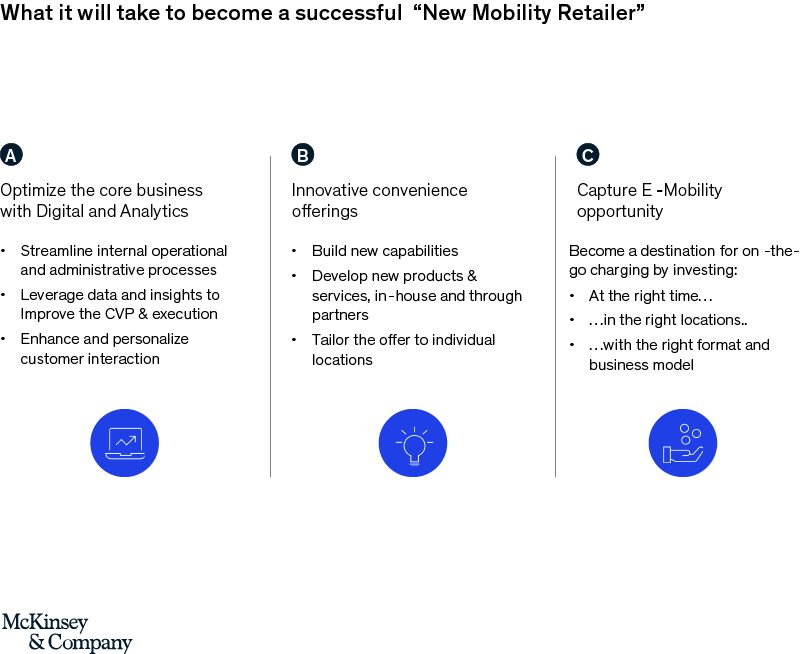Over the past two decades, the global retail industry has been fundamentally disrupted by the rise in e-commerce, which started with books and music and was followed by grocery and food delivery; now you can buy almost anything online. The fuel-retail industry (also known as forecourt retail and roadside retail), has hardly been affected—selling gasoline over the internet for home delivery is not very easy.
However, disruption has finally arrived to this industry through the rapid growth of electric vehicles, which is starting to affect fuel volumes in the early-adoption markets in China, Northwestern Europe, and parts of the United States. And this is only the beginning of what we anticipate to be an accelerating worldwide trend toward e-mobility that will substantially affect fuel sales and cause a reduction in visits to fuel stations over the coming years.
This fundamental change will also create meaningful opportunities for fuel retailers that evolve with the mobility-retail landscape. These new mobility retailers can offer an attractive destination for drivers to spend ten to 20 minutes when their cars are recharging. We anticipate that such on-the-go charging will be used for one out of five charges and that a stop for EV charging can be considerably more than filling up a car with fuel.
We believe that fuel retailers can do three things as new mobility retailers to lead the industry transition now that disruption has finally entered their sector:
- Leverage advancements in digital and advanced analytics to optimize the core business by streamlining processes, generating rich customer insights, and building a personal connection with customers
- Build a distinctive convenience-retail solution with destination offerings (such as car care, food for later, groceries, and unique fresh food and beverages) developed either in house or in partnership with other brands.
- Become a destination for on-the-go EV charging by investing at the right time in the right locations with the right offering and business model.

In this series of podcasts we at McKinsey will be sharing our perspective on what companies can do to lead the industry transition and benefit now that disruption has finally entered the world of fuel retail.
Over the past decade, fuel and convenience retail has been one of the more resilient segments in the oil and gas industry. The growth of both out-of-home consumption and small-format retail has enabled forecourts to capture significant incremental value from convenience retail and other nonfuel retail (NFR) business. As a result, industry asset values have soared. For example, acquisition multiples for US convenience stores have almost doubled—from six to seven times annual EBITDA a decade ago to ten to 12 times today—and now well exceed the multiples of integrated oil and gas companies. Apart from strong profitability, often exceeding 20% ROACE, this is also a result of operators having access to a large number of adjacent value pools allowing them to create multiple customer connections.
Innovative fuel and convenience retailers play across the full space of fuels, convenience and services adjacencies. They cluster their networks according to local customer needs, such as “food to go,” “food for later,” “take a break”, “car care center” or innovative “fleet hubs”. They are also developing new or additional business models; for example, developing forecourts into destinations for food shopping, click and collect, pharmacy and postal services; forming partnerships & alliances to share locations with companies such as McDonald’s and Starbucks; and enabling their customers to interact with them in seamless digital and engaging way.
The industry is offering a lot of exciting developments – in this series of short podcasts we at McKinsey will be bringing insights into industry’s performance as well as ideas for players to get ahead to position themselves for success in this rapidly evolving industry.